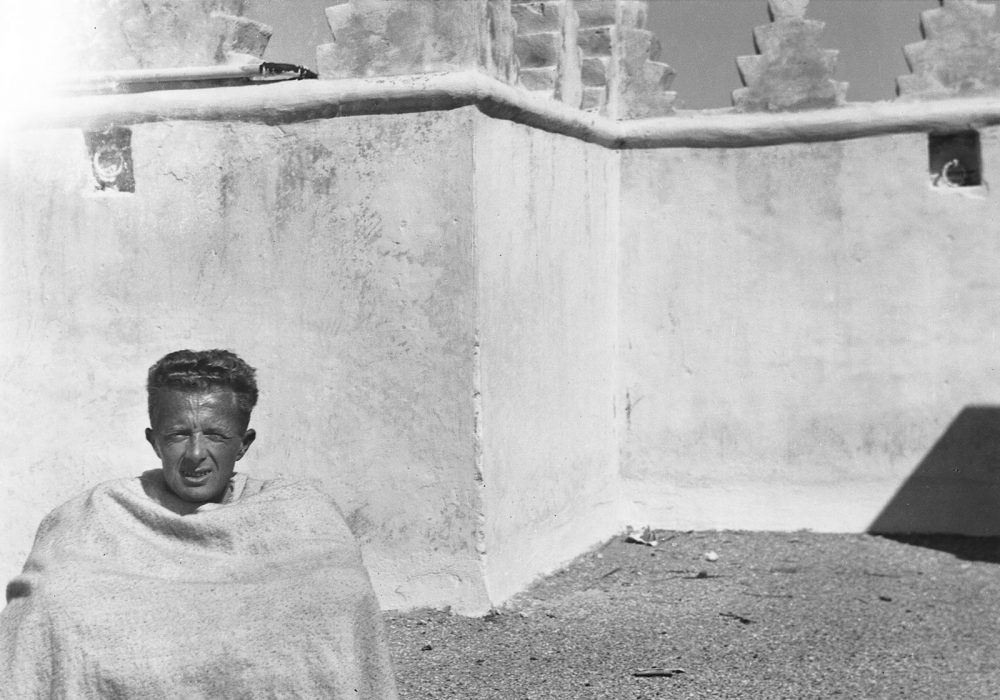A Queer Ear: Paul Bowles’ “Music of Morocco”
Ben Miller examines how Paul Bowles’ recordings of traditional Moroccan music might have served an agenda of resistance.

Paul Bowles in Fez, Morocco, in 1947. Courtesy Dust-to-Digital and the Library of Congress. via the New York Review of Books.
Three Americans—a woman, her husband, and his friend—sit in a café in Morocco a few years after the end of World War II. The woman, bored, muses on their travels, “The people of each country get more like the people of every other country. They have no character, no beauty, no ideals, no culture, nothing.” Her husband replies condescendingly, “You’re right…Everything’s getting gray and it’ll be grayer. But some places’ll withstand the malady longer than you think.”
Paul Bowles wrote this scene (from his 1949 novel The Sheltering Sky) as an American expatriate in Tangier drawn there by music. At the suggestion of Gertrude Stein, he first traveled to Morocco in 1931 with his friend and composition teacher Aaron Copland, who, irritated by the heat, left soon after they arrived. Bowles, on the other hand, was captivated. Immediately, he sent several records he found at flea markets to Béla Bartók, the Hungarian composer who, along with other left-wingers at the time, was determined to avoid the grey advance of capitalist monoculture through the preservation of indigenous music.
Two decades later, on a grant from the Rockefeller Foundation and with the begrudging permission of a post-Independence Moroccan government intent on promoting a unified nationalist cultural identity, Bowles traveled the country recording traditional music of the Amazigh, Arabic, Andalusian, and Sephardic people. This project was no doubt limited by and complicit in whiteness—both Bowles’ own and that of his audiences in Europe and America. Preparing for the recordings’ first release, Bowles selectively edited the pieces to emphasize sections he found more artistic and exotic. In one case, he insisted on recording a solo wind instrument, the qsbah, apart from its usual ensemble.
These recordings, until recently only available in Bowles’ excerpted forms, have been restored, re-edited, and released this year in an expanded box set from Dust-to-Digital, the Atlanta-based record label responsible for revolutionizing the distribution of American folk music. The restoration of these cuts is a blessing for music lovers, and Bowles’ unedited recordings themselves do not necessarily objectify or otherize the artists. His impulse, like that of Bartók, is still best understood in terms of respect, preservation, and even resistance. As Brian T. Edwards notes in regard to Bowles’ literary representations of Morocco, he repeatedly challenged the binary “between cultural production and political history…he published a novel about the Moroccan independence movement…feared returning to the US because of prior membership in the Communist party…and saw his own extensive recording of Moroccan music in the postcolonial period as a response to the [anti-indigenous] cultural program of Moroccan nationalists.”
Indeed, during the time of Bowles’ membership in the Communist Party in the 1930s and ’40s in New York, leftists, folk singers, and art-music composers (many queer, like Bowles) united in an organization called People’s Songs that sought to preserve American folk music and political culture through field recordings, performance, and advocacy. One People’s Songs teacher, Harry Hay, who would later become one of the earliest gay activists and theorists in America, developed a class in 1948 that theorized a universal, folk-music language of class resistance. While there is no record of Bowles taking the class, the typewritten syllabus and similar ideas circulated widely through left-wing artistic and intellectual circles. In the accompanying notes to one of the box set’s recordings, the “Aouada Trio,” performed by Rais Mahamad ben Mohammed and his ensemble, Bowles hypothesizes a musical connection to Morris dance, a form of politically-tinged folk-jesting from England. Surely Bowles could not have known that, simultaneously to his making these recordings, Harry Hay was theorizing Morris dance as a centerpiece of a queer-indigenous political resistance. And yet the adjacency of these ideas is intoxicating.
In a Tashelhit song titled “El Baz Ouichen,” performed by singer and bowed lute player Rais Ahmed ben Bakrim, an initial melody names a clever jackal as the subject of the song. The piece evolves into a repeating chant that Bowles cut from the original published recordings. The booklet for the Dust-to-Digital version quotes his field notes: “When the recording was played back, [Ahmed] had a fit of laughter which so affected him that he fell over backwards and had to be helped back into a sitting position by the other musicians.” In the updated liner notes, an expert in Tashelhit poetry explains the laughter that mystified Bowles. The tune had been “a song of seduction,” improvised so that Bowles was positioned as a “white bird” (an object of desire) being pursued by Ahmed’s jackal. Perhaps it was just a joke at the expense of this strange skinny foreigner equipped with wires and microphones. But maybe it was a more serious proposition, an invitation (sexual? political? musical?) ignored. Music of Morocco invites us—residents of a world more overwhelmed by the greyness than Paul Bowles could have feared—to accept.
Editor's Note
Music of Morocco was released April 1, 2016, as a box set from Dust-to-Digital.



